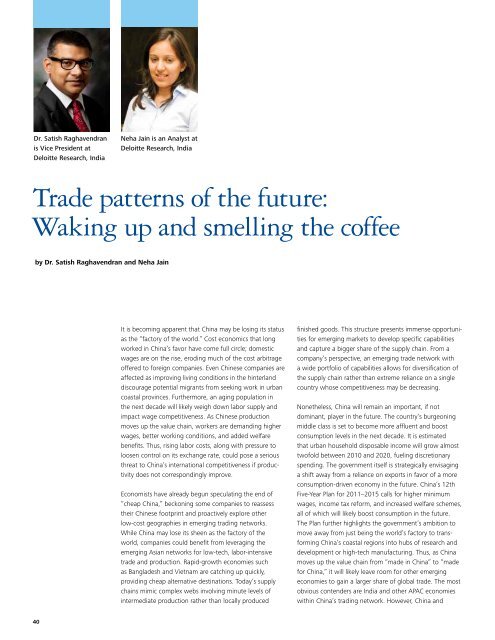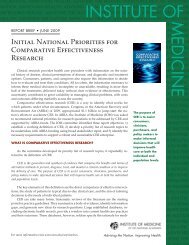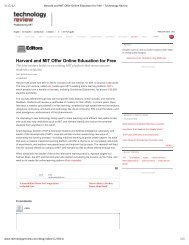You also want an ePaper? Increase the reach of your titles
YUMPU automatically turns print PDFs into web optimized ePapers that Google loves.
Dr. Satish Raghavendran<br />
is Vice President at<br />
<strong>Deloitte</strong> Research, India<br />
40<br />
Neha Jain is an Analyst at<br />
<strong>Deloitte</strong> Research, India<br />
Trade patterns <strong>of</strong> the future:<br />
Waking up and smelling the c<strong>of</strong>fee<br />
by Dr. Satish Raghavendran and Neha Jain<br />
It is becoming apparent that China may be losing its status<br />
as the “factory <strong>of</strong> the world.” Cost economics that long<br />
worked in China’s favor have come full circle; domestic<br />
wages are on the rise, eroding much <strong>of</strong> the cost arbitrage<br />
<strong>of</strong>fered to foreign companies. Even Chinese companies are<br />
affected as improving living conditions in the hinterland<br />
discourage potential migrants from seeking work in urban<br />
coastal provinces. Furthermore, an aging population in<br />
the next decade will likely weigh down labor supply and<br />
impact wage competitiveness. As Chinese production<br />
moves up the value chain, workers are demanding higher<br />
wages, better working conditions, and added welfare<br />
benefits. Thus, rising labor costs, along with pressure to<br />
loosen control on its exchange rate, could pose a serious<br />
threat to China’s international competitiveness if productivity<br />
does not correspondingly improve.<br />
Economists have already begun speculating the end <strong>of</strong><br />
“cheap China,” beckoning some companies to reassess<br />
their Chinese footprint and proactively explore other<br />
low-cost geographies in emerging trading networks.<br />
While China may lose its sheen as the factory <strong>of</strong> the<br />
world, companies could benefit from leveraging the<br />
emerging Asian networks for low-tech, labor-intensive<br />
trade and production. Rapid-growth economies such<br />
as Bangladesh and Vietnam are catching up quickly,<br />
providing cheap alternative destinations. Today’s supply<br />
chains mimic complex webs involving minute levels <strong>of</strong><br />
intermediate production rather than locally produced<br />
finished goods. This structure presents immense opportunities<br />
for emerging markets to develop specific capabilities<br />
and capture a bigger share <strong>of</strong> the supply chain. From a<br />
company’s perspective, an emerging trade network with<br />
a wide portfolio <strong>of</strong> capabilities allows for diversification <strong>of</strong><br />
the supply chain rather than extreme reliance on a single<br />
country whose competitiveness may be decreasing.<br />
Nonetheless, China will remain an important, if not<br />
dominant, player in the future. The country’s burgeoning<br />
middle class is set to become more affluent and boost<br />
consumption levels in the next decade. It is estimated<br />
that urban household disposable income will grow almost<br />
tw<strong>of</strong>old between 2010 and 2020, fueling discretionary<br />
spending. The government itself is strategically envisaging<br />
a shift away from a reliance on exports in favor <strong>of</strong> a more<br />
consumption-driven economy in the future. China’s 12th<br />
Five-Year Plan for 2011–2015 calls for higher minimum<br />
wages, income tax reform, and increased welfare schemes,<br />
all <strong>of</strong> which will likely boost consumption in the future.<br />
The Plan further highlights the government’s ambition to<br />
move away from just being the world’s factory to transforming<br />
China’s coastal regions into hubs <strong>of</strong> research and<br />
development or high-tech manufacturing. Thus, as China<br />
moves up the value chain from “made in China” to “made<br />
for China,” it will likely leave room for other emerging<br />
economies to gain a larger share <strong>of</strong> global trade. The most<br />
obvious contenders are India and other APAC economies<br />
within China’s trading network. However, China and











